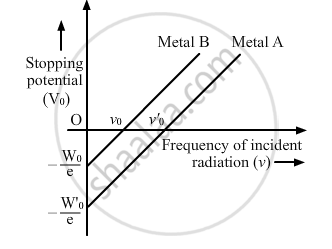Advertisements
Advertisements
Question
Consider an electron in front of metallic surface at a distance d (treated as an infinite plane surface). Assume the force of attraction by the plate is given as `1/4 q^2/(4πε_0d^2)`. Calculate work in taking the charge to an infinite distance from the plate. Taking d = 0.1 nm, find the work done in electron volts. [Such a force law is not valid for d < 0.1nm].
Solution
As per question F = `1/4 q^2/(4πε_0d^2)`
Let at any instant electron is at a distance x from the metal surface. Force of attraction between. metal surface and electron is F
F = `1/4 q^2/(4πε_0x^2)`

Work done by an external agency in taking the electron from distance d to ∞ is W.D. = `int_d^∞ F*dx`
W.D. = `int_d^∞ (q^2dx)/(4 xx 4πε_0x^2) = q^2/(4 xx 4πε_0) int_d^∞ x^-2 dx = q^2/(4 xx 4πε_0) x^-1/(-1)`
W.D. = `(-q^2)/(4.4πg e_0) [1/x]_d^∞ = (-q^2k)/4 [1/∞ - 1/d]`
W.D. = `(+ kq^2)/(4d)` [d = 0.1 nm = 10–10 m]
Work done is positive
So W.D. = `((1.6 xx 10^-19)^2 xx 9 xx 10^9)/(4 xx 10^-10)`
J = `(1.6 xx 9 xx 1.6 xx 10^(-33+9+10))/(4 xx 1.6 xx 10^-19)` eV
= `(9 xx 1.6 xx 10^(19+19))/4`
= 3.6 eV
APPEARS IN
RELATED QUESTIONS
The photoelectric work function for a metal surface is 2.3 eV. If the light of wavelength 6800A is incident on the surface of metal, find threshold frequency and incident frequency. Will there be an emission of photoelectrons or not?
[Velocity of light c = 3 x 108 m/s,
Planck’s constant, h = 6.63 * 10-34 Js ]
Draw a neat labelled circuit diagram of experimental arrangement for study of photoelectric effect.
The graph shows the variation of stopping potential with frequency of incident radiation for two photosensitive metals A and B. Which one of the two has higher value of work-function? Justify your answer.

A photosensitive surface emits photoelectrons when red light falls on it. Will the surface emit photoelectrons when blue light is incident on it? Give reason.
What change will you observe if intensity of incident radiation is changed but the frequency remains the same?
A beam of monochromatic radiation is incident on a photosensitive surface. Answer the following question giving reason :
Does the kinetic energy of the emitted electrons depend on the intensity of incident radiation?
Draw a plot showing the variation of photoelectric current with collector plate potential for two different frequencies, v1 > v2, of incident radiation having the same intensity. In which case will the stopping potential be higher? Justify your answer.
What is photoelectri effect ? Defin (i) Stopping potential (ii) Photoelectric work function.
With reference to the photoelectric effect, what is meant by threshold wavelength?
The phenomenon of photoelectric emission was observed by ______.
